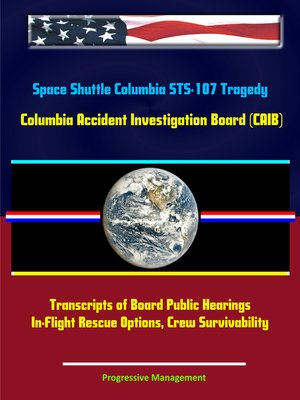Space Shuttle Columbia STS-107 Tragedy
ebook ∣ Columbia Accident Investigation Board (CAIB) Transcripts of Board Public Hearings, In-Flight Rescue Options, Crew Survivability
By Progressive Management

Sign up to save your library
With an OverDrive account, you can save your favorite libraries for at-a-glance information about availability. Find out more about OverDrive accounts.
Find this title in Libby, the library reading app by OverDrive.



Search for a digital library with this title
Title found at these libraries:
| Loading... |
Three elements of the Columbia Accident Investigation Board (CAIB) final report are reproduced in this ebook. The CAIB reported on the last flight of space shuttle Columbia, which ended in the horrible, sudden loss of the vehicle and crew during entry on February 1, 2003. The report has been professionally converted for accurate flowing-text ebook format reproduction.
Part One provides a complete reproduction of the transcripts of the board public hearings.
Part Two discusses the in-flight rescue options assessment submitted by the NASA Accident Investigation Team. The NASA team was asked by the Columbia Accident Investigation Board (CAIB) to determine whether there were any options available to return the STS-107 crew. The one significant initial condition in this request was that engineers were aware that there was damage to the leading edge of the left wing that could be ascertained either through the use of national assets or through EVA inspection. Whether this was the actual condition on STS-107 is not known. Two different options were studied: a rescue mission with the Space Shuttle Atlantis, and a repair by the STS-107 astronauts, using materials available onboard Columbia. To determine the amount of on-orbit time available for each of these options, significant effort was spent in the analysis of how on-orbit consumables could be preserved. It was determined that the limiting consumable was lithium hydroxide (LiOH), which is used to remove carbon dioxide from the crew compartment atmosphere. Using real crew metabolic rates and an estimate of acceptable CO2 concentration levels, it was determined that the maximum on-orbit lifetime was 30 days total Mission Elapsed Time (MET), or until the morning of February 15. Other consumables, such as oxygen, hydrogen, nitrogen, food, water, and propellant were assessed and determined to provide support beyond 30 days MET (Columbia Flight Day 30).
Part Three, on crew survivability, includes the report submitted by Dr. James Bagian, astronaut and Chief Flight Surgeon and Donald White of the USAF. While not the root cause of the mishap, understanding the cause of the loss of the crew will provide information that can be utilized in the design and planning of future space missions and vehicles to increase the probability of survival in the event of mishap.
The opening statement of the board's report says: "We sought to discover the conditions that produced this tragic outcome and to share those lessons in such a way that this nation's space program will emerge stronger and more sure-footed. If those lessons are truly learned, then Columbia's crew will have made an indelible contribution to the endeavor each one valued so greatly. After nearly seven months of investigation, the Board has been able to arrive at findings and recommendations aimed at significantly reducing the chances of further accidents. Our aim has been to improve Shuttle safety by multiple means, not just by correcting the specific faults that cost the nation this Orbiter and this crew. With that intent, the Board conducted not only an investigation of what happened to Columbia, but also to determine the conditions that allowed the accident to occur – a safety evaluation of the entire Space Shuttle Program."
The executive summary states: "The Board recognized early on that the accident was probably not an anomalous, random event, but rather likely rooted to some degree in NASA's history and the human space flight program's culture. Accordingly, the Board broadened its mandate at the outset to include an investigation of a wide range of historical and organizational issues, including political and budgetary considerations,...






